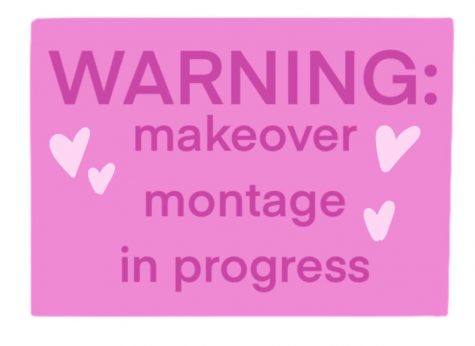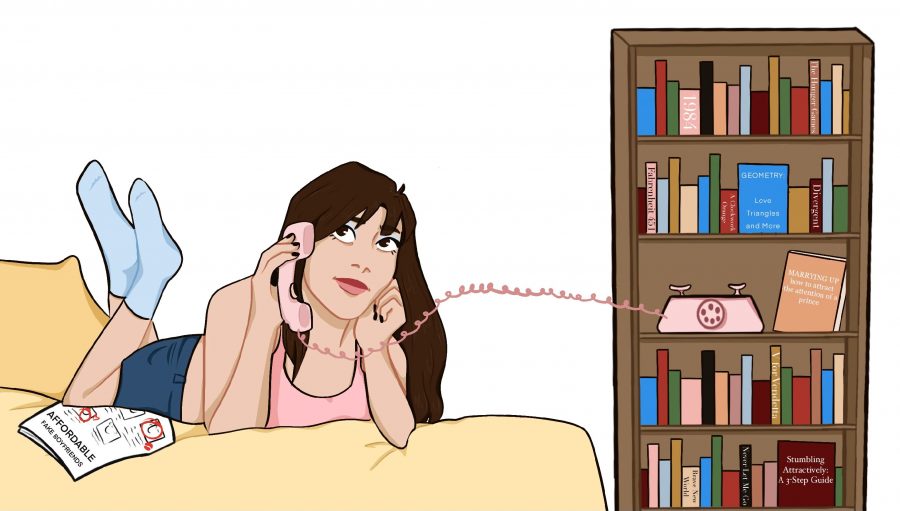The Mittle-man on Campus: Jumping Genres
Lying on her bed, the Mittle-Man contemplates whether romance is the genre of her story.
November 19, 2021
‘The Mittle-man on Campus’ is a satirical column centered around high school clichés and the teenage experience. None of the articles in this column are representative of the opinions of The Chronicle staff as a whole.
Welcome back, devoted fans, to the only column worth reading! Hopefully, everybody had a thrilling Halloween romance (or two) and is ready to replace the cobwebs, doom and gloom with a good, old-fashioned holiday love story. I know I am.
As a talented columnist with a penchant for romance, I spent most of my time dreaming up relationships. However, growing older has helped me discover that reality isn’t always what it appears. With this newfound wisdom, I have come to the conclusion that my advice is a little too centered around the romantic comedy genre. Even though every single rom-com protagonist eventually falls in love, we’re almost three months into the school year and I don’t even have a boyfriend. How can I ride off into the sunset on a white horse with the man of my dreams if I haven’t even met him yet?
Considering I have yet to find true love on campus, it’s possible that (as painful as it is to say) our school just doesn’t fit the genre. At first, this revelation left me stunned and devastated. After all, I’ve spent my entire life waiting for an attractive, popular high school boy to fall in love with me, and now, I’m being faced with the reality that things might not go as planned. However, I know I can’t wallow in disappointment; as the designated school Advice Giver, it’s my responsibility to write for the student body. With this in mind, I spent a couple of hours brainstorming, and by the end, I discovered another category of media our school can fall under. Without further ado, I present to you: young adult dystopian.
I know, it may seem jarring that I have jumped from preaching light-hearted romantic comedy to advocating for its polar opposite, but before you roll your eyes, allow me to explain my reasoning for this conclusion. After listing all of the classic dystopian cliches, I think you’ll find yourself in agreement with my analysis.

Every dystopian involves an insanely restrictive government that metes out harsh punishment for small crimes. Think about it. Is the school’s soul-crushing start time of 8:00 a.m. so different? Getting up that early in the morning is punishment alone, but we also face the wrath of our fellow students’ sleep deprivation-induced mood swings. The counter-evidence I can provide for my point is the existence of Peer Support. After all, dystopias typically don’t have cuddly emotional support groups that sit in a circle, eat potato chips and talk about their feelings off the record. This brings me to a new theory: Peer Support is actually in league with the diabolical System, feeding confidential information to the government so the military knows who to neutralize next. Are we truly surprised? The settings of these group meetings are English classrooms, haunted by the ghosts of failed in-class essays. The entire thing is deeply foreboding, looking back on it now.
Young adult dystopian novels often involve some type of rigid categorization between individuals in society. High schoolers are generally separated from one another by age, which the oppressive government refers to as “grade levels.” Sophomores are humble peasants without rights or respect; few, if any, positions of power belong to them. They struggle through mandatory Lifelab and Chemistry courses. Even their elected Prefects are ruled by upperclassmen, and they are sequestered to an isolated secondary cafeteria to be neither seen nor heard. Juniors are the middle class, forced to do the hard labor of the rich and successful to make a living. After their difficult workdays, they spend their time struggling through AP U.S. History reading, hoping to advance to a higher social position or at least a decent grade. At the top of the high school hierarchy, seniors are the all-powerful upper class with the luxury to briefly escape captivity for up to 55 minutes during their lunch break. They run all of the clubs and receive generous first-quarter grades. But even within grade levels, the population finds itself segmented into factions, each residing in a different habitat. Some students spend their time on the Quad tables while others make themselves at home in the Chalmers Lounge. The different factions clustered around campus are essentially pre-categorized into the different “Divergent” groups. I mean, it’s pretty Dauntless to sit five feet from a dean’s office all day.
An indispensable aspect of all dystopias is some cataclysmic event that destroys the previous society and creates anarchy. Well, it’s been nearly two years since a deadly plague swept the nation. No wonder the cruel System was so convincing to desperate high school students—they would accept any relief from that unrelenting, disease-ridden nightmare.
Teens frequently find themselves battling one another to the death in dystopias. The government in “The Hunger Games,” for example, randomly chooses two teenagers from each sector to engage in mortal combat, and the individuals are forced to participate. Maybe it’s a stretch, but the animalistic tension between students waiting in daily lunch lines is enough to make me wonder if we’re that far off from those gladiator brawls.

Is a society even dystopian if it doesn’t require its citizens to follow bizarre, arcane rituals? It may not be the same thing as the Two Minutes hate from “1984” but most other schools don’t have a Senior Ring Ceremony. Our flower crowns are straight out of “Midsommar” and the rings are likely tracking devices. And that’s not all: the different Spirit Week dress-up days are a perfect example of the System’s strange traditions. I mean, Pajama Day? So society can see what I sleep in at night in order to gather personal information about me? I don’t think so. Frankly, Bring your Own Blanket Day was an egregious attempt to instill conformity and manipulate our sleep schedules. Plus, Prefect Council was clearly exploiting our childhood reliance on soothing objects to convince us to trust the System, and I’m not having it. On that topic, Halloween is the strangest tradition of all. Society obviously wants us to dress up as terrifying fictional characters to distract from the real looming threat of the oppressive System.
All dystopias use odd terminology specific to their society. “The Maze Runner” has a plethora of examples: The Changing, Grievers and The Maze. Our school does the exact same thing, my readers. The Deans, Community Time and Co-Curricular are only a few of the strange vocabulary terms we regularly use.
At this point, I think it’s pretty clear that dystopia is simply the more accurate genre for our school. This is not to say we can’t enjoy the benefits of a post-apocalyptic nightmare society. The dangerous, authoritarian government makes it more fun to sneak around. The looming threat of exile helps us live in the moment, and we even have the opportunity to join the underground resistance and start a revolution. Plus, the biggest benefit to living in a YA dystopia is that one of us has to be the Chosen One. Whoever it is (and I’m not saying it’s myself, although all signs point to me) must take down the System before it’s too late, Katniss Everdeen-style. Sure, The Chosen One has to whine that they never asked for this difficult role, but we all know it’s the best possible position. After all, the protagonist is essentially immune to death during high-stakes battles. Any close side character, however—especially the main character’s childhood best friend or reasonably insignificant sibling—is as good as dead.
So don’t fret, dear readers. Because we live in a dystopia, we can only go up from here. The most important thing we can do is to stay positive and wait for the revolution to start. In the meantime, dystopian romances are the next best thing.
And remember: if I go missing in the next few days, you’ll know the System has caught on.






























